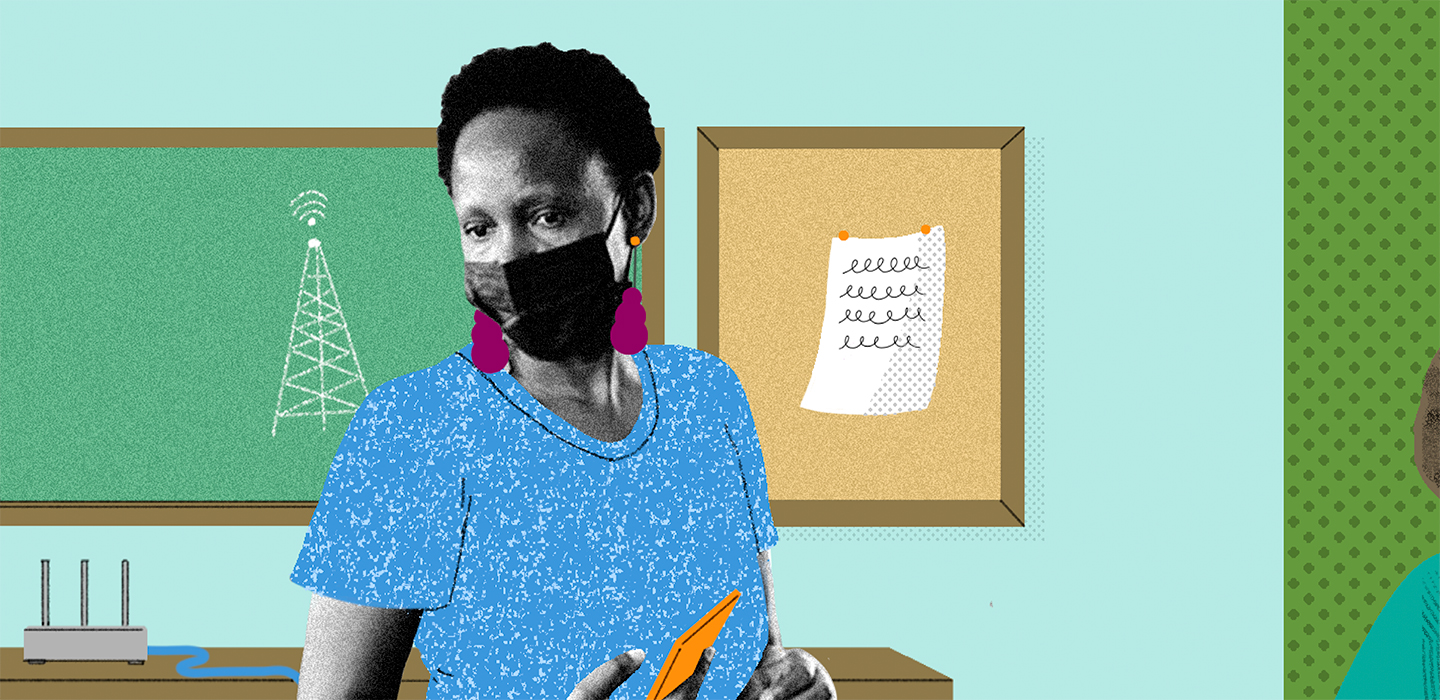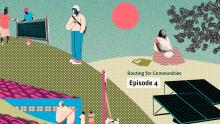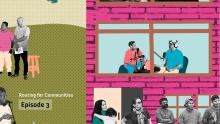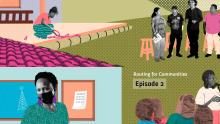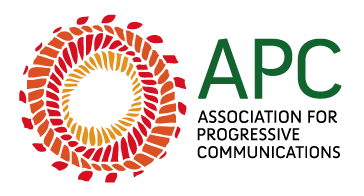#1 Women connecting a village
Have you ever stopped to wonder how no access to the internet affects one's work, studies, access to information and communication? And how this can reflect and, at the same, time reinforce inequalities? It is to change such a digital divide that community networks have been established around the world.
In our first episode, we discover an inspiring experience from South Africa: the Mamaila Community Network, which is connecting a rural area that had been ignored by major providers, while building digital skills. And we learn more about community networks with Kgopotso Magoro from South Africa and Claire Milne from the UK, our interviewees for this episode.
Histories and voices that are intertwined, connected by one thread: building internet and communication community networks.
Hi, my name is Renata Porto, I’m Brazilian, and we are recording this episode here in our studio in the city of São Paulo.
I will follow you along this twelve-episode season.
In this podcast, I invite you on a journey to meet community-led experiences that have come up with solutions to overcome the challenges of digital inclusion in remote, rural and urban areas across the globe.
Tell me: How are you listening to this podcast right now? Do you have broadband at your house? Are you using mobile data? Do you have to walk long distances to get connectivity? Is your internet connection affordable and reliable or you'll struggle to finish listening to this episode?
Have you ever stopped to wonder how no access to the internet affects one's work, studies, access to information and communication with friends and family? And how this can reflect and, at the same, time reinforce inequalities?
Well, around 2.9 billion people – 37% of the world's population – have never used the internet, according to the publication “Measuring digital development: Facts and figures 2021”. The figures also show that the situation can be worse depending on the country one lives and if we look at differences in gender, age, income or between urban and rural areas for example.
And it is to change such digital divide that community networks have been established out there.
Here you are going to listen to life stories of those who build innovative and bold community-led initiatives to connect themselves and defend the rights and well-being of their communities.
Today I will tell you about an experience straight from South Africa: the Mamaila Community Network, which took the internet to a rural area that had been ignored by major communications’ providers in the country.
“I first got exposed to computers and internet when I was about 19, after leaving the village.”
“Women are fully capable when they're trained to carry out the technical work involved in a community network.”
Come with me to meet Kgopotso Magoro from South Africa and Claire Milne from the UK, our interviewees for this episode.
Routing for communities: An audio journey tracing community connectivity around the world.
We are now travelling to the province of Limpopo, in the north of South Africa, on the border with Zimbabwe and Mozambique. That is where the Mamaila Community Network is located, taking the internet to rural areas where the digital world had been nothing but a distant reality.
This network was created so that the inhabitants of the communities could have access to the internet at affordable prices, through their own community-led Wi-Fi network.
The Mamaila Community Network comes into being in the province of Limpopo, which has over five million people, 97% being black and more than 63% over 29 years old. The main mother language is Sepedi, besides a number of other local languages and dialects. The inhabitants live primarily off of agriculture, such as different citrus, corn, potatoes, tea, tobacco and peanuts, besides cattle farming.
In the extensive rural areas that mark the province, the project is named after the location where it came into being: the Mamaila Village. This is a group of six hamlets from the Greater Letaba municipality, located at least 370 kilometres away from Pretoria. Mamaila Village has a little less than nine thousand inhabitants.
“My name is Kgopotso Ditshego Magoro. I was born and bred in a village called Mamaila, which is in the Limpopo province, South Africa.”
This is Kgopotso [pronunciation: rro-po-so]. Even though she no longer lives in Mamaila, she has her roots there. That is why, years after leaving the rural area in search of education and work opportunities, she went back to the region with one objective: to create a community network for digital inclusion.
Kgopotso’s tone of voice is calm, but it doesn’t show that, in fact, there is a great story of overcoming challenges underneath. She participated in our recording online through her cellphone, using a mobile connection. This is because constant electricity cuts in the country have affected the place where she was on that day.
During the interview, Kgopotso tells us that she currently lives in Pretoria, the executive and administrative capital of South Africa. And, oh yeah, South Africa doesn’t have just one capital. There’s Pretoria, where the Presidency is; Cape Town, where Parliament is; and Bloemfontein, where the Judiciary branch works.
Nowadays, Kgopotso works for the country’s Department of Finances, but before then, her life was very different.
“I was born in Mamaila Village, where I grew up without access to infrastructure in schools, clinics, hospitals, everything that you can think of as infrastructure. So, access to computers, internet, it's not something that even exists in our environment and this is mainly because I'm old. I'm 44, you know? So, when I was growing up those things didn't exist in the village. I first got exposed to computers and internet when I was about 19, after leaving the village. Getting to university and having to interact with children who were socialised, you know, around computers and as a rural child when you get that your first struggle is to understand what is discarded, you have heard about it, that there's something called the computer, but you're seeing it for the first time when you are 19, so it was just fascinating for me.”
As soon as she had access to computers, Kgopotso tells us she decided to take a course on typing. At the time, she understood that technology could open doors for her to work as a secretary.
With her certificate in hand, she managed to get an internship at the government’s Communication’s Department, and she was then introduced to the internet by her work mates. In her own words, it was as if the world had been open before her eyes.
“So that changed my way of understanding technology, because for the first time I was able to go to many places, sitting at the desk, using this computer through the internet. And they created my first email and told me that you can use this to look for jobs, communicate with other people. So that was in 1999 when I first interacted with computers at that level, learning how to use the internet.”
Two years later, Kgopotso tells us she went back to Limpopo unemployed and needed to use cyber cafés to turn in job applications. The problem is that using internet there was expensive, and that is when she decided to have internet at home.
The difficulties to make the internet work, and to understand the problem with such a slow connection, made her interested in the subject. And this is how she went on to get a master’s degree in Policies and Regulations of Communication and Information Technology, focusing on the challenges for rural connectivity.
She then aligned her academic interests with practical transformations and actions in her own community – a journey she is continuing – continuing this journey, now in her PhD. These were the seeds of what would come to be the Mamaila Community Network, which started as an idea to be tested in 2019 and was launched in 2022.
“As I was exploring and learning more about the possibilities of creating a community network, I couldn't do the decrement of Mamaila Community Network as an individual, because, first of all, I am a student and my presence in this space is more of a research scholar and I don't work for any organisation in the South African ecosystem that deals with the internet. Realising that, it was possible for me to contribute to the solution by deploying a community network. I first needed to apply for a license to be able to deploy the network and that's where the Zuri Foundation came in. They assisted with the process of securing the license as an NGO. And once we secured the network license, throughout this process we have been working with the community of Mamaila through the Mamaila Royal Council.”
During the process of consolidating the community network, many civil society organisations supported the project, which was gradually formulated at the Zuri Foundation. This is an organisation created by Kgopotso and other community members to develop projects of digital inclusion in her community, amongst them, the Mamaila Community Network. However, the fundamental aspect was that the partnership should be established with the community, which took place through Mamaila’s Tribal Authority, an organising tribal authority based on the tribal culture of the villages and their identities. This is how Kgopotso puts it.
“The project Mamaila Community Network takes its name from the name of the village, which was part of us creating a sense of identity for the community network. The community of Mamaila it’s a tribe that is known as Balobedu. Historically, we are part of the Rain Queen known as Modjadji, the Rainmaking. Our totem it’s a wild peak, so we believe and still hold to our cultural heritage.”
With the support of the tribal authority, which has offered a place where their own tower for internet access is located, the project has been developed under the mottos: “Connecting the unconnected” and "Connecting people with the future”. Their own tower, finalised in 2022, enabled them to eliminate dependency on the infrastructure of a mobile carrier, making it possible, if need be, to change suppliers in the future.
Since its official launch in March 2022, over 3,000 devices connected to Mamaila Community Network. Nowadays, the operating tower covers two villages through six hotspots – which are Wi-Fi internet spots. Each hotspot has its own capacity for up to 200 simultaneous connections on retail. The next step is to expand the service for the remaining villages.
The community can connect via Wi-Fi by purchasing vouchers, which give them access to the internet for a limited amount of time, and for a price that is approximately one third of the cost at private operators. If you want to know more about this community network, follow the handle @mamailanetwork (all together) on Twitter.
While the digital network grows, Mamaila’s community has also been developing itself. However, as Kgopotso tells us, just like in other villages in South Africa, people are still subject to high unemployment rates and precarious life conditions. For example, lack of sustainable and reliable energy, as well as water.
“The village is growing and there's a lot of changes that are happening. We do have people who go through the education system like myself. So as much as we are a village and we are a village that suffered from the apartheid system of forcing the people out of the village to work as migrant labourers in housing, what I can see is that the village and the spirit of the village and is that of resilience. The dynamics in the communities that we've got majority of people or households are led by women.”
Resilience is evident in Kgopotso’s account and experiences, as well as the women’s from Mamaila Village. They lead their households and also great projects for community life and society. Such strong heritage is part of Kgopotso, the oldest of four sisters, who, alongside their mother, have been her support system in the construction of Mamaila Community Network.
“Because this journey you can’t walk it as an individual. You need to have solidarity in your own household, in your village and outside of your village. So thank you so much.”
A few days after the interview with Kgopotso, she sent us a message with a few videos and a song from the community. Kids are singing in the local language, about the Mamaila Community Network, telling people they can now access the internet thanks to “The Girl”, making a reference to her, followed by a shy emoji. The ones singing are school girls from Mamaila’s Primary School, where Kgopotso studied, located next to her house in the village.
The Mamaila Community Network shows women actively building community networks. Women that understand that working with information and communication technologies can be a place to strengthen personal and collective autonomy and self-determination.
After talking to Kgopotso, we decided to video call with Claire Milne, from the UK.
Claire is a kind, retired researcher who worked for several years at the London School of Economics. Besides a vast knowledge in the area of telecom policies around the world, Claire participated as a mentor in a capacity and movement building programme developed by the Local Networks initiative. The programme, called Socio-Political Advocacy for Community Networks Engagement, aims to support women and people to take on leadership roles in community networks ecosystem advocacy. Claire worked as Kgopotso’s advisor in the programme in 2021.
“I think as a generalisation, women are often the best communicators. They are traditionally the people who hold families together, who everybody talks to and uses as the hub point to find out about other parts of the family and they're the best connected within their communities too, so they've got vital roles to play in bringing people together and resolving conflicts. And there will be conflicts in any major project in a community like this one. So, I think women are often the best place to get things started on a community network and then when you get to the point of actually building a network, well of course, women are fully capable when they're trained of carrying out the technical work involved in a community network.”
To take advantage of Claire’s expertise, we asked how she analyses the process of construction and internal strengthening of community networks across the globe.
“There's a lot of enthusiasm already at the grassroots level, but that's not necessarily everywhere. There may be some communities which really could use a network of their own and then not being served by the national operators and they won't be served for some time, and they would really benefit by a community network. But they haven't thought about doing it themselves. So, there is room there for more awareness raising. And that I think it best comes from other community networks in the same country, reaching out and telling their fellows that ‘this can be done and look what we're doing in it’. If there aren't any who are available to do that, well, APC is doing a fantastic job, and I think this talk that we're having at the moment is part of the outreach activities that APC, and of course, it has member organisations in many parts of the world, that they can do and through other like-minded organisations.”
Initiatives like Mamaila Community Network are not alone in this journey, but they are part of an ecosystem of community-led initiatives that are responding to local needs from within the definition of a community network.
Community networks show there is not one single solution for the digital gap, while various alternatives have been built from local knowledge.
We’ve reached the end of this episode. I hope that Mamaila's story and transformative projects of digital inclusion can reach you as an inspiration for action.
If you’ve liked this episode, please recommend this podcast to those you know will appreciate it as well. You can follow the season on the main podcast platforms or on APC’s website: routingforcommunities.apc.org
We’ll meet again soon, with new experiences and stories from community-led networks that are also connected to our lives.
Credits
This podcast is an initiative from the Association for Progressive Communications (APC) and Rhizomatica, produced by Rádio Tertúlia.
Script and production: Vivian Fernandes
Script translation: Thiago Moyano
Script proofing: Drew McKevitt
Presentation: Renata Porto
Editing and voice-over support: Beatriz Pasqualino
Sound: Lua Gatinoni
Coordination: Beatriz Pasqualino and Débora Prado
Consulting Board: Flavia Fascendini, Kathleen Diga, Cynthia El Khoury, Bruna Zanolli, Nils Brock and Daniela Bello
Illustrations: Gustavo Nascimento
Web design: Cathy Chen and Avi Nash
